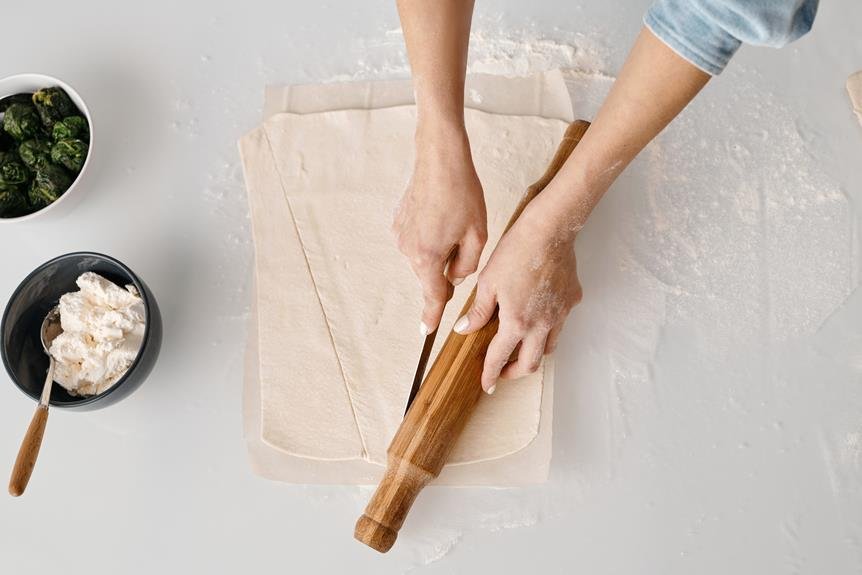Do you ever wonder if your homemade keto bread is prone to mold? Well, we've got the answer for you.
In this article, we'll explore the factors that contribute to mold growth on keto bread and provide you with tips to prevent it. By understanding the ingredients and conditions that promote mold formation, you can ensure your keto bread stays fresh and mold-free.
So, let's dive in and discover the secrets to keeping your keto bread mold-free.
Key Takeaways
- Keto bread has a lower moisture content compared to regular bread, which makes it less prone to mold growth.
- The absence of sugar in keto bread inhibits mold formation.
- Ingredients like almond flour or coconut flour in keto bread have natural antimicrobial properties, helping to prevent mold growth.
- Proper storage and handling of keto bread, such as storing in a cool, dry place and using airtight containers, can prevent mold formation.
Mold Growth and Keto Bread
Does keto bread's mold growth differ from regular bread's?
When it comes to mold growth, there's a significant difference between keto bread and regular bread.
Keto bread, being low in carbohydrates, lacks the moist environment that molds thrive in. Mold requires moisture to grow and reproduce, and since keto bread has a lower moisture content compared to regular bread, it becomes less susceptible to mold growth.
The absence of sugar in keto bread also inhibits mold formation, as molds feed on sugars present in regular bread. Additionally, keto bread often contains ingredients like almond flour or coconut flour, which have natural antimicrobial properties that can further inhibit mold growth.
However, it's important to note that keto bread can still mold, especially if it isn't stored properly. Moisture from the environment or improper storage can provide enough moisture for mold to grow on keto bread. Therefore, it's crucial to store keto bread in a cool, dry place and consume it within a reasonable time frame to minimize the risk of mold growth.
Ingredients in Keto Bread Recipes
One of the key factors in keto bread recipes is the choice of ingredients. Since the ketogenic diet is low in carbohydrates, traditional bread ingredients like wheat flour aren't used. Instead, keto bread recipes often rely on alternative flours such as almond flour, coconut flour, or flaxseed meal. These flours are low in carbs and high in healthy fats, making them suitable for a keto diet.
In addition to the choice of flour, other ingredients in keto bread recipes may include eggs, butter or oil, baking powder, and salt. Eggs are often used as a binding agent and provide structure to the bread. Butter or oil adds moisture and richness to the bread, while baking powder helps the bread rise. Some recipes also call for low-carb sweeteners like erythritol or stevia to add a touch of sweetness without spiking blood sugar levels.
Factors Affecting Mold Formation on Keto Bread
To understand the factors affecting mold formation on keto bread, you need to consider the moisture content and storage conditions. Moisture plays a crucial role in mold growth, as it provides a suitable environment for spores to germinate and develop into mold. High moisture levels in the bread can accelerate mold formation, especially in warm and humid conditions. Therefore, it's essential to ensure that the keto bread is baked thoroughly and cooled properly before storage.
Proper storage conditions are equally important in preventing mold growth on keto bread. Storing the bread in a cool and dry place can help maintain its freshness and inhibit mold formation. It's recommended to store keto bread in airtight containers or plastic bags to minimize exposure to air and moisture. Additionally, keeping the bread away from direct sunlight and other sources of heat can prevent the growth of mold.
Furthermore, it's vital to regularly inspect the bread for any signs of mold. Even if the bread is stored in optimal conditions, it's still possible for mold to develop over time. Therefore, it's crucial to discard any bread that shows signs of mold growth, such as visible spores or a musty odor.
Tips to Prevent Mold on Homemade Keto Bread
To prevent mold on your homemade keto bread, follow these tips.
First, make sure your bread is completely cooled before storing it. Warm or hot bread can create a moist environment, which is ideal for mold growth.
Additionally, store your bread in an airtight container or bag to prevent moisture from getting in. Moisture is a primary factor in mold formation, so keeping your bread dry is crucial.
Next, consider adding natural mold inhibitors to your bread recipe. Ingredients like apple cider vinegar or lemon juice can help prevent mold growth. These substances create an acidic environment that inhibits mold growth. You can also try adding a small amount of salt, as it acts as a natural preservative and can help prevent mold from developing.
Furthermore, storing your bread in a cool and dry place can also help prevent mold growth. Avoid storing it in humid areas like the kitchen or near the sink. Instead, choose a pantry or cupboard that's well-ventilated and dry.
Lastly, make sure to consume your bread within a reasonable timeframe. While keto bread tends to have a longer shelf life than traditional bread, it's still best to consume it within a few days to minimize the risk of mold growth.
Conclusion: Is Keto Bread Prone to Mold?
Keto bread isn't inherently prone to mold. While mold can grow on any type of bread, including keto bread, there are several factors that can influence its susceptibility to mold. Here are four reasons why keto bread may be less prone to mold:
- Low moisture content: Keto bread recipes often use ingredients like almond flour or coconut flour, which have lower moisture content compared to traditional wheat flour. Mold requires moisture to grow, so the low moisture content in keto bread can make it less favorable for mold development.
- Absence of sugar: Traditional bread recipes typically contain sugar, which provides a food source for mold. In contrast, keto bread recipes usually avoid or minimize the use of sugars. The absence of sugar can inhibit mold growth and reduce the chances of mold forming on keto bread.
- High fat content: Keto bread recipes often include ingredients like butter or olive oil, which contribute to the high fat content. Fat acts as a natural preservative and can help extend the shelf life of bread by creating an inhospitable environment for mold.
- Use of preservatives: Some keto bread recipes may incorporate natural preservatives, such as apple cider vinegar or lemon juice, which can help inhibit mold growth. These preservatives create an acidic environment that makes it difficult for mold to thrive.
While keto bread isn't immune to mold, these factors can make it less prone to mold growth compared to traditional bread. However, it's still important to store and handle keto bread properly to prevent mold formation.
Conclusion
In conclusion, keto bread can be prone to mold growth due to its unique ingredients and low carbohydrate content. Factors such as humidity, temperature, and storage conditions can also affect mold formation on keto bread.
However, by following proper storage tips and using preservatives, it's possible to prevent mold on homemade keto bread. It's important to be aware of these factors and take necessary precautions to ensure the freshness and safety of keto bread.






0 Comments